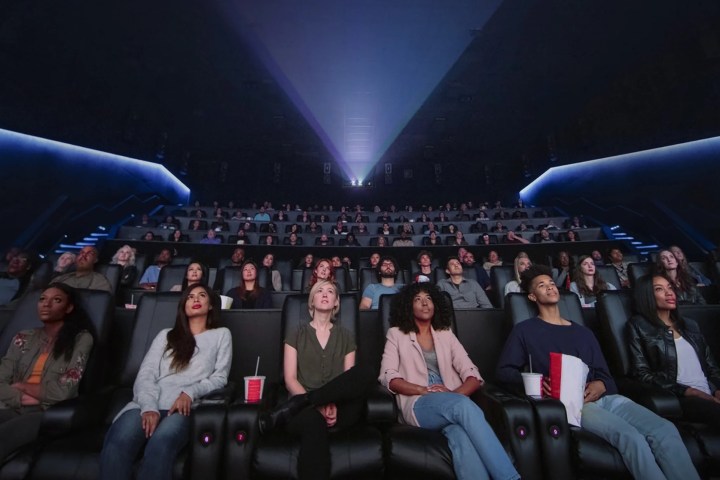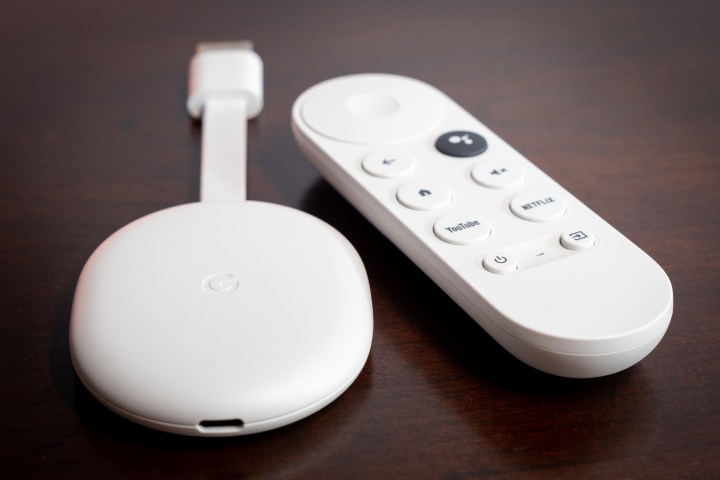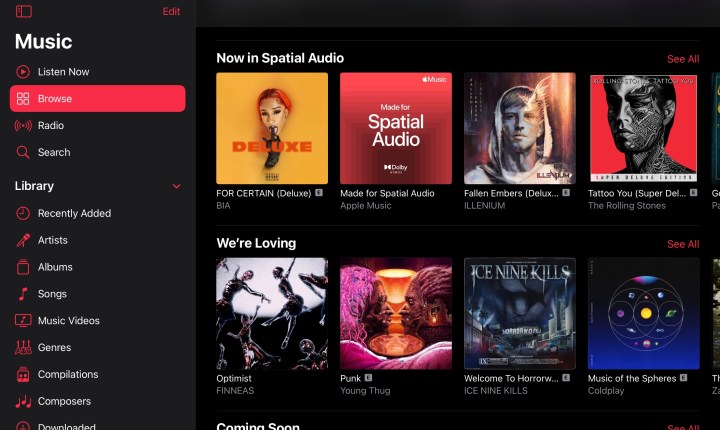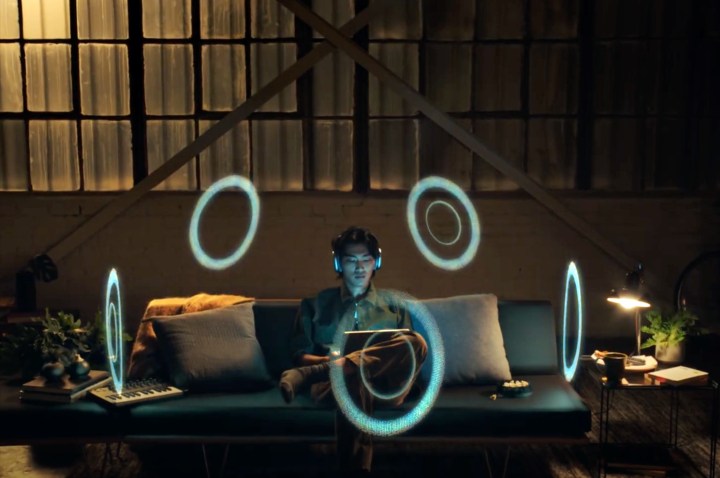Over the years, we’ve seen our fair share of trends in the audio industry, like hi-res audio, active noise cancellation, and whole-home multiroom wireless speakers. In 2021, those trends all took a back seat to the earthquake that is Dolby Atmos. What started out as a seismic shift in the sound systems used in commercial movie theaters is now sending reverberations through every aspect of home and mobile entertainment, from streaming services to soundbars, and even the tunes you listen to during your daily commute. Not familiar with Dolby Atmos? Here’s a guided tour to the ways it shaped 2021, and will continue to evolve in the years to come.
From movie theater to home theater

What is Dolby Atmos? For a deep dive into the technology, I recommend you take a stroll through our no-stones-left-unturned Dolby Atmos explainer, but here’s the short version: It’s an advanced form of surround sound with two distinct characteristics. First, it uses “height channels” — usually in the form of ceiling speakers or up-firing speakers — that let sounds appear to be coming from above you. Standard 5.1, 7.1, or even 9.1 surround sound systems only place their speakers around you, not above you.
Second, Dolby Atmos lets audio engineers treat sounds as objects that can be moved around freely in 3D space, independently of any other sounds. The classic example is the sound of a helicopter that can start deep in the front of your TV room, then rise up, fly overhead, and gradually disappear behind you — all while the movie’s score continues to play from all of your speakers at once.
Taken together, these qualities make Dolby Atmos a far more immersive sound experience than traditional stereo or even previous surround sound formats. Thanks to Dolby Atmos-compatible A/V receivers, soundbars, and even speakers built into TVs, there are now plenty of versions of Dolby Atmos for the home, with prices starting at just $150.
Streaming support

One of the keys to getting Dolby Atmos at home is having access to movies or TV shows that have been produced with Dolby Atmos soundtracks. For years, this was the exclusive domain of 4K UHD Blu-ray discs, but in 2021, nearly every major on-demand streaming media service offered titles in Dolby Atmos. Some, like Netflix, charge a premium price for this surround-on-steroids sound, but others, like Disney+, Apple TV+, and Amazon Prime Video, include it in their standard tiers.
Unfortunately, Dolby Atmos has yet to make its way into all traditional TV platforms, but the evolution is under way. Comcast used its X1 platform to deliver the 2020 Tokyo Games (broadcast in 2021) in both Dolby Vision and Dolby Atmos — a special event, to be sure, but also a sign of things to come. Live TV streaming equivalents like YouTube TV, Sling TV, and Hulu + Live TV, still lack Dolby Atmos support but this could change in the near future.
NextGen TV (aka ATSC 3.0) — the latest evolution of digital over-the-air TV — was built to accommodate Dolby Atmos, but we’re not aware of any TV stations that are broadcasting Dolby Atmos content yet. Most cable companies offer set-top boxes that support Dolby Atmos, but this is typically only used to support the streaming service apps, not cable TV channels.
Hardware support: Streaming devices

Streaming devices that support Dolby Atmos used to be expensive, like the Apple TV 4K or Nvidia Shield TV, but by 2021, we saw Atmos on the feature list of every single model in our best streaming devices roundup.
This doesn’t mean that every streaming device offers the same Atmos experience. Some provide native, hardware-based decoding of Dolby Atmos, while others simply passthrough the Atmos signal to a downstream device like a TV or soundbar. But either way, you can buy a streaming device with Atmos support for as little as $30.
Hardware support: Audio devices

Audio devices like soundbars are following a similar trend, with an increasing number of products that offer Dolby Atmos processing and prices that are incredibly accessible. This year brought nearly every major brand under the Dolby Atmos soundbar umbrella, with a variety of models from Vizio, LG, Sony, Sonos, Samsung, JBL, Bose, Bang & Olufsen, Monoprice, TCL, and more.
Like streaming devices, there are differences in how these soundbars support Atmos. Some use a full complement of dedicated speakers with up-firing drivers for a true 5.1.2 or better surround sound experience. These tend to be the more expensive units. But others are able to produce what’s known as a “virtualized” Dolby Atmos sound from as few as two channels. These soundbars won’t be as immersive as a discrete system, but they’re still better than non-Atmos speakers and they cost far less than their fancier Atmos cousins.
Hardware support: TVs

If you value simplicity, and thus use your TV’s built-in software and streaming apps for all of your media needs, having a TV that supports Dolby Atmos is vital. It doesn’t necessarily have to be able to play Dolby Atmos through its own speakers (an improvement on standard stereo, but still pale when compared to dedicated soundbars or receivers), but it does need to be able to receive and passthrough Dolby Atmos to a compatible soundbar or A/V receiver via HDMI ARC or eARC.
The good news is that 2021 was the year that Atmos support effectively became universal on all but the least expensive TVs.
Made for music

As much as Dolby Atmos has reshaped the home movie landscape through new speakers and streaming gadgets, 2021 was also the year Atmos began to change how we listen to music — and on a device most of us already own — the smartphone.
Record labels and independent artists have started recording songs in Dolby Atmos Music — the same immersive 3D experience for home theaters, but instead of being used to move a helicopter around your room, artists use it to place listeners “inside” their songs, taking advantage of the extra height and depth that Dolby Atmos can create.
A wide variety of artists from The Weeknd to Billie Eilish to Olivia Rodrigo to John Williams have all produced music using the Dolby Atmos toolset.
A is for Atmos, Apple, and Amazon

Dolby Atmos Music made its streaming debut on Amazon Music HD in 2019, but it remained limited to just Amazon’s $199 Echo Studio smart speaker. No other devices, whether made by Amazon or third parties, were compatible with the new music format.
Tidal soon followed with its own Dolby Atmos Music offering, but it too was severely limited — you needed an Atmos-compatible streaming device that was also compatible with the Tidal app and a Dolby Atmos sound system.
But in 2021, Apple decided to jump into spatial audio for streaming music, and added its own Dolby Atmos Music catalog to Apple Music. At the same time, it announced that anyone who owned an iPhone 7 or newer (or several iPad models) could hear Dolby Atmos Music using any set of wired or wireless headphones. And if you owned one of Apple’s AirPods family of headphones, you’d hear Atmos Music versions of songs automatically.
Super spatial audio

Apple’s move into Dolby Atmos Music created a massive tent for the 3D format almost overnight. After starting with iOS/iPadOS, it then added Dolby Atmos Music to its Apple Music apps for select Android devices, increasing Atmos’ audience even further.
But Apple also wanted to do something unique with spatial audio, and in 2021 it began to leverage onboard sensors found in the AirPods Pro, AirPods Max, and eventually the 3rd gen AirPods) to enable head-tracking spatial audio.
If normal Dolby Atmos and Dolby Atmos Music are used to create a greater sense of immersion through a 3D sound field, head-tracking spatial audio levels up that experience by adjusting that sound field in real time in response to head movements.
For movies, it creates a virtual theater environment, using just your headphones and an iPhone or iPad to mimic what it’s like to sit in a 5.1.2 or better Dolby Atmos home theater. For music, it keeps key song elements like vocals or lead guitar temporarily anchored to a position that’s “in front” of you, which can simulate what it’s like to be sitting front and center as a band performs on stage or in a studio.
Amazon takes Atmos Music everywhere

Not to be outdone, Amazon also made 2021 the year it massively expanded its Dolby Atmos Music footprint. You can now stream Dolby Atmos Music tracks from Amazon Music on any mobile device thanks to Amazon’s inclusion of Dolby audio technology right in the Amazon Music app.
In late 2021, Sonos announced that you can stream Dolby Atmos Music tracks from Amazon Music directly to Sonos’ Atmos-compatible soundbars, marking the first time these speakers can play Atmos Music without the help of a third-party streaming device.
Automagic

If Dolby Atmos Music is so good, why should it be limited to soundbars and headphones? In 2021, Dolby Atmos took its first steps into the automotive realm, first with the Lucid Air EV, then an announcement that Mercedes Benz will be adding Dolby Atmos sound systems to many of its ultra-high-end touring sedans like the Maybach.
In November, Dolby Labs announced that it had partnered with Chinese auto maker Nio, to equip the company’s flagship electric sedan, the ET7, with a Dolby Atmos sound system as standard equipment.
We’ve seen a number of collaborations between vehicle builders and audio companies, like Audi/Sonos and Jeep/McIntosh, but given that Dolby Atmos isn’t tied to any one audio company, it’s a good bet that the immersive surround sound format will makes its way into many more cars in 2022 and beyond.
Massive momentum
It’s fair to say that in 2021, Dolby Atmos had a big moment as support for it grew among major video and music streaming services and device manufacturers. And even though there are still holdouts — Spotify being the 800-pound gorilla that can’t be ignored — I suspect we’ll look back at 2021 as the year that Dolby Atmos became a genuinely mainstream audio technology, accessible to anyone who wants to experience it conveniently and at a reasonable price.
With that kind of audience momentum, it likely won’t be long before it becomes ubiquitous among movie and TV productions and across the music industry.
If you haven’t had your first Dolby Atmos experience yet, 2022 will almost certainly be the year that you do.
Editors' Recommendations
- Vizio shrinks the price of a Dolby Atmos soundbar to $99
- Samsung launches its flagship Dolby Atmos soundbar with discounted prices
- Tidal has rolled all of its premium features into its $11 per month plan
- You Asked: VR home theater, universal remotes, and Dolby Atmos music
- Dolby’s Vegas flex: in person with FlexConnect and Dolby Atmos in-car



